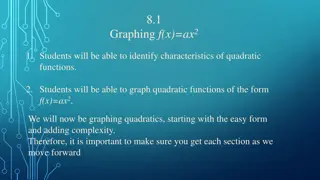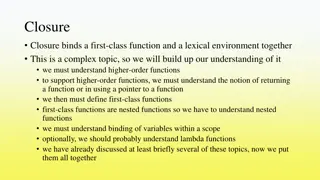Understanding Parent Functions and Their Characteristics
This informative content explores different parent functions such as linear, quadratic, cubic, square root, reciprocal, exponential, and logarithmic functions. It delves into their unique properties, graphs, and functions, offering insights into domain, range, and key characteristics of each function type.
- Parent Functions
- Mathematical Concepts
- Functions Overview
- Graphical Representations
- Function Characteristics
Download Presentation

Please find below an Image/Link to download the presentation.
The content on the website is provided AS IS for your information and personal use only. It may not be sold, licensed, or shared on other websites without obtaining consent from the author. Download presentation by click this link. If you encounter any issues during the download, it is possible that the publisher has removed the file from their server.
E N D
Presentation Transcript
PARENT FUNCTIONS Linear Quadratic Cubic Square Root Reciprocal Exponential Logarithmic Absolute Value
LINEAR Linear The graph of a linear function is a line. Lines are characterized by a slope, usually denoted (m) and a position on the plane, usually given by an x- or a y- intercept (b). Functional form (slope-intercept form): f(x) = mx + b Linear equations (standard form): Ax + By = C
QUADRATIC Quadratic The graph of a quadratic function (and only a quadratic function) is a parabola. Parameters: vertex location, direction of opening and steepness of rise or drop. Function form: f(x) = ax2+ bx + c, a, b and c are constants. All even functions of xnresemble this shape
CUBIC Cubic The graph of a cubic function is S-shaped or "sigmoid." The parent function has inversion symmetry about (x, y) = (0, 0). That point is called an inflection point, the point where the curvature of the graph changes sign. Functional form: f(x) = ax3+ bx2+ cx + d, where A, B, C and D are constants. Cubic and higher functions are generally referred to as polynomial functions. All odd functions of xnresemble this shape.
SQUARE ROOT Root Root functions have an exponent of the independent variable that is less than one. Root functions are characterized by rapid growth for small values of x, with slower growth as x increases. Note that the domain (the "allowed" values of x) of a root function with an even exponent (like 1/2) is always [0, ), while an odd exponent (like 1/3) gives (- , ).
RECIPROCAL Reciprocal Function A reciprocal function is one in which x is in the denominator. Because these functions have variables in the denominator, the denominator can approach zero for certain values of x, which leads to asymptotic behavior. In this example, both of the graph axes are asymptotes
EXPONENTIAL Exponential ? ? = ?? In an exponential function, the independent variable is in the exponent, thus exponential functions grow very rapidly compared to polynomial functions.
LOGARITHMIC Logarithmic ? ? = log(?) Logarithmic functions are the inverses of exponential functions. They grow continuously as the independent variable grows, but the rate of growth diminishes, too.
ABSOLUTE VALUE Absolute values carry the magnitude of the value, regardless of whether the value is positive or negative. This means that absolute values are always positive. Absolute Value: ? ? = ? They can usually be characterized in a graph by the sharp corner in the function.























